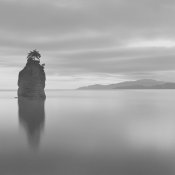This image:
I am thinking:
- high sharpness lens and format (hasselblad/zeiss, that much I know from the tags)
- b/w super high dynamic range film (plus-x, also from the tags)
- ND filter to smooth out the water
- focus on the rock to the left (or closer than that) and (very)small aperture to get basically the whole scene in focus
- no polarizer (light is low anyway, non-reflective)
and now the difficult part:
- exposure: spot-metered on the large hill at the far end, which seems to be middle-greyish (maybe this is too simplistic and the image needs zone-system metering, which I am not yet capable of)
Sounds right?
I am thinking:
- high sharpness lens and format (hasselblad/zeiss, that much I know from the tags)
- b/w super high dynamic range film (plus-x, also from the tags)
- ND filter to smooth out the water
- focus on the rock to the left (or closer than that) and (very)small aperture to get basically the whole scene in focus
- no polarizer (light is low anyway, non-reflective)
and now the difficult part:
- exposure: spot-metered on the large hill at the far end, which seems to be middle-greyish (maybe this is too simplistic and the image needs zone-system metering, which I am not yet capable of)
Sounds right?






